Velopharyngeal Function and Disfunction
To understand velopharyngeal function, it is important to know about the structures in the mouth. Figure 1 shows the structures of the roof of the mouth: the hard palate and the soft palate. The soft palate is also called the velum. This figure also shows the tonsils, which are toward the back of mouth on each side.
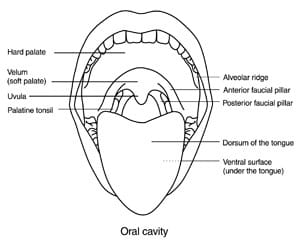
FIGURE 1
During normal speech, air from the lungs and sound from the vocal cords (in the larynx, or “voice box”) travel upward in the throat (pharynx). To produce most speech sounds, the air and sound need to be directed into the mouth and blocked from entering the nasal cavity. This is done through closure of the velopharyngeal valve.
The velopharyngeal valve consists of the following structures:
- Velum (soft palate)
- Lateral pharyngeal walls − side walls of the throat
- Posterior pharyngeal wall − the back wall of the throat
Figure 2 shows the velum resting against the back of the tongue during normal nasal breathing. During inhalation, air can flow through the nose and pharynx down to the lungs without obstruction. Exhalation of carbon dioxide follows the same path in reverse.
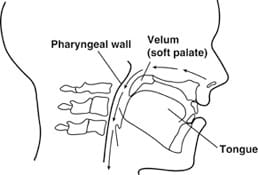
FIGURE 2
Figure 3 shows how the velum rises to close against the posterior pharyngeal wall during speech. At the same time, the lateral pharyngeal walls (not shown in the diagram) move to close against the soft palate. This results in a sphincter-type closure. Velopharyngeal closure also occurs during swallowing, gagging, vomiting, sucking, blowing and whistling.
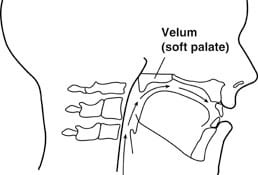
FIGURE 3
Velopharyngeal dysfunction (VPD) is a general term. It describes disorders of the velopharyngeal valve, including velopharyngeal insufficiency (VPI), velopharyngeal incompetence (VPI) and velopharyngeal mislearning.
Figure 4 shows velopharyngeal insufficiency (VPI). This disorder is caused by an abnormality of the structures, and is common in children with a history of cleft palate or a submucous (under the skin) cleft.
Velopharyngeal insufficiency can also occur after adenoidectomy, although the incidence is rare (about one in 2,500 cases). This is because the adenoids are in the area of normal velopharyngeal closure.
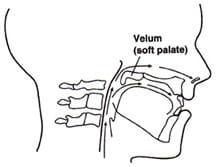
FIGURE 4
Figure 5 shows the position of the adenoid pad in the throat.
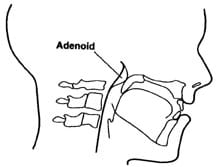
FIGURE 5
Figure 6 shows velopharyngeal incompetence, which is caused by poor movement of the velopharyngeal structures. The inadequate movement of the velopharyngeal structures is usually due to a neurological disorder or injury (as in cerebral palsy or traumatic brain injury).
Some children have a form of velopharyngeal dysfunction called velopharyngeal mislearning. In this case, the velopharyngeal valve does not close appropriately during speech because the child has not learned to use it correctly.

FIGURE 6
Velopharyngeal dysfunction can cause the following speech characteristics:
- Hypernasality, or too much sound in the nose during speech
- Nasal emission of air during consonant production
- Weak or omitted consonants due to inadequate air pressure in the mouth
- Short utterance length due to the loss of air pressure through the nasal cavity
- Compensatory articulation productions, or speech sounds produced in a different way to compensate for the lack of air pressure in the mouth
Contact Us
For more information about the VPI Clinic, contact Katherine Diana, 513-636-0336.



